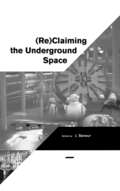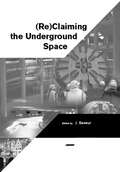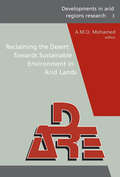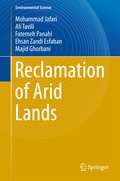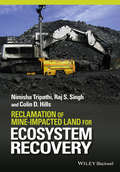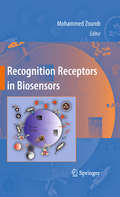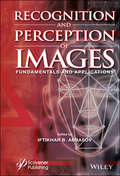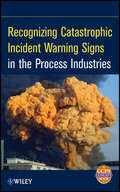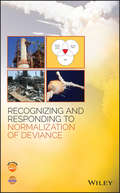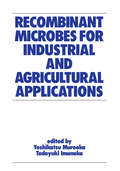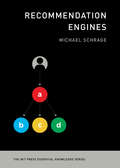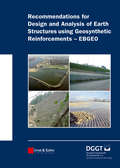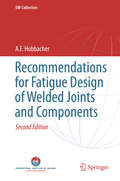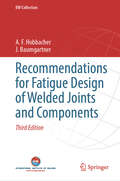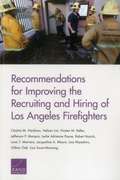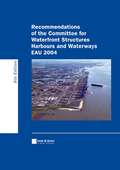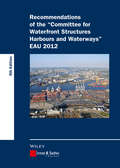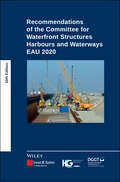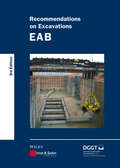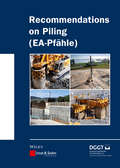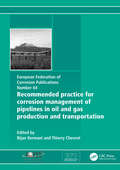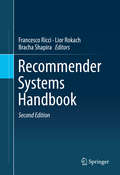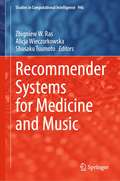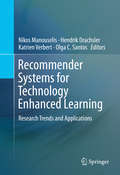- Table View
- List View
Reclaiming The Underground Space - Volume 1: Proceedings of the ITA World Tunneling Congress, Amsterdam 2003.
by J. SaveurThis book contains papers, presented at the ITA World Tunnelling Congress 2003 held in Amsterdam, which reflects the state of the art with regard to research, analysis, design and practical experience in almost all fields of tunnelling and underground space construction.
Reclaiming The Underground Space - Volume 2: Proceedings of the ITA World Tunneling Congress, Amsterdam 2003.
by J. SaveurThis book contains papers, presented at the ITA World Tunnelling Congress 2003 held in Amsterdam, which reflects the state of the art with regard to research, analysis, design and practical experience in almost all fields of tunnelling and underground space construction.
Reclaiming the Desert: Proceedings of the Third Joint UAE-Japan Symposium on Sustainable GCC Environment and Water Resources (EWR2006), 30 January - 1 February 2006, Abu Dhabi, UAE.
by A.M.O. MohamedA comprehensive collection of contributions from the Middle East and Japan, dealing with pressing problems concerning sustainability in arid zones, this time with the accent on environmental science and engineering. The symposium brought together researchers and field engineers who discussed issues such as sulphur utilization in agriculture and con
Reclamation of Arid Lands (Environmental Science and Engineering)
by Mohammad Jafari Ali Tavili Fatemeh Panahi Ehsan Zandi Esfahan Majid GhorbaniThis book provides an overview of arid and semi-arid lands conditions, their general characteristics, methods of management, conservation, exploitation and reclamation. It also focuses on how to utilize the potential of arid lands with the minimum manipulation and alteration. Arid and semi-arid areas represent a major part of natural ecosystems not only in Iran, but around the world, and mismanagement and inappropriate exploitation of these areas may lead to further gradual degradation. As such, an understanding of the characteristics of these areas is vital if they are to be conserved and reclaimed.
Reclamation of Mine-impacted Land for Ecosystem Recovery
by Colin D. Hills Raj S. Singh Nimisha TripathiMining activities significantly impact the environment; they generate huge quantities of spoil, promote deforestation and the loss of agricultural production, as well as releasing contaminants that result in the loss of valuable soil resources. These negative impacts are now being recognized and this book shows how corrective action can be taken. The introduction of sustainable mining requires mitigation strategies that start during the mine planning stage and extend to after mineral extraction has ceased, and post-closure activities are being executed. Reclamation of Mine-impacted Land for Ecosystem Recovery covers: methods of rejuvenation of mine wasteland including different practices of physical, chemical and ecological engineering methods; benefits of rejuvenation: stabilization of land surfaces; pollution control; aesthetic improvement; general amenity; plant productivity; and carbon sequestration as well as restoring biodiversity and ecosystem function; best management practices and feasible solutions to the impacts of mining which will reduce the pollution load by reducing the discharge rate and the pollutant concentration; reduce erosion and sedimentation problems, and result in improved abandoned mine lands; and ecosystem development. The authors explain how mining impacts on soil properties and how soil carbon reserves/soil fertility can be restored when mining has ceased. Restoration involves a coordinated approach that recognizes the importance of key soil properties to enable re-vegetation to take place rapidly and ecosystems to be established in a low cost and sustainable way. This book's unique combination of the methods for reclamation technologies with policies and best practice worldwide will provide the background and the guidance needed by scientists, researchers and engineers engaged in land reclamation, as well as by industry managers.
Recognition Receptors in Biosensors
by Mohammed ZourobThis book will cover most of the up-to-date recognition receptors technologies used in biosensors. Since this book is written by the world's most renowned and learned scientists in their own area of expertise, we believe that the calibre of the finished product will be as renowned as their reputation. To the best of the editor and author's knowledge this book is a first in this field. We will aim to cover this increasingly hot area of research especially in relation to the new biosensing techniques. Most of the universities are teaching the recognition receptors topics in the Biosensors, separation and Microsystems courses. However, there is no single reference book that covers this interesting area. So the aim of this book is to be a textbook for the undergraduate and graduate student upwards, and an important reference for the professionals working in different fields including biomedical, natural sciences, physical sciences, and nanotechnology, m-TAS, veterinary, food QA, bioterrorism and security as well as health surveillance. The book will cover the different recognition receptors used up-to-date in the different sensing transducer and microarrays platforms. It will cover the background, theory behind each technology, state-of-the-art review for all the new technologies used in biosensing in detail. Strategies and future prospectus are suggested at the end of each chapter for developing future technologies to achieving a better sensitivity, stability and swifter biosensing detection.
Recognition and Perception of Images
by Iftikhar B. AbbasovThis book is dedicated to the unique interdisciplinary research of imagery processing, recognition and perception. The contents of this book are based on the concepts of mathematical processing, compositional analysis applied in the art and design, and psychological factors of the information perception process. The conduction of compositional analysis carried out in the course of images processing and recognition, creation of the image project solution and modeling of the conceptual space structures are considered together with the mechanism of their perception. Edited and written by a group of international experts, the practical applications for industry are covered, including the influence of internet memes on social networks and face recognition technology subject to interferences. The algorithms of perception and improving of accuracy necessary for satellite imagery recognition and complex reflection from the object are represented with the use of artificial neural networks. Not just a study in how humans recognize and perceive images, this outstanding new volume delves into how these processes are used in technology for continuously evolving industrial applications. Whether for the veteran scientist or engineer, or for the student, this is a must-have for any library.
Recognizing Catastropic Incident Warning Signs
by CcpsThis book provides guidance on characterizing, recognizing, and responding to warning signs to help avoid process incidents and injuries before they occur. The guidance can be used by both process safety management (PSM) professionals in evaluating their processes and PSM systems as well as for operators who are often the frontline defense against process incidents. Warning signs may consist of process deviations or upsets, instrumentation warnings or alarms, past operating history and incidents, observable problems such as corrosion or unusual odors, audit results indicating procedures are not being followed, or a number of other indicators. Filled with photos and practical tips, this book will turn anyone in a process plant into a hazard lookout and will help prevent potential incidents before they turn into catastrophic events.
Recognizing and Responding to Normalization of Deviance
by CcpsAn essential guide for recognizing and responding to normalization of deviance to help organizations improve their process safety performance This book provides an introduction and offers approaches for finding and addressing normalization of deviation both in operational and organizational activities. It addresses the initial and long-term effects of normalization of deviations as seen in reduced efficiencies, reduced product quality, extended batch run time, and near miss process safety incidents which can lead to loss of containment of hazardous materials and energies. Recognizing and Responding to Normalization of Deviance addresses how to recognize and respond to the normalization of deviation that can, and almost certainly will, occur in any ongoing operations that involves humans. The book’s primary focus is on reducing the incidence of normalization of deviation and the associated increased risk exposure due to its effects when operating chemical or petrochemical manufacturing facilities. It contains an introduction to the concept and offers approaches for finding and addressing normalization of deviation when it presents itself in both operational and organizational activities. Contains guidance to assist facilities in recognizing and addressing the phenomenon of normalization of deviation Provides techniques for addressing normalized deviations and techniques to eliminate waste in all manufacturing processes Describes methods for identifying normalized deviation as well as where to find deviations Includes techniques to reduce operational normalization of deviance and to reduce organizational normalization of deviance Aimed at process safety professionals and consultants applying process safety risk reduction efforts in manufacturing areas, Recognizing and Responding to Normalization of Deviance is an important book for any organization that has seen its process safety performance deteriorate over time.
Recombinant Microbes for Industrial and Agricultural Applications
by Yoshikatsu Murooka, Tadayuki lmanakaBridging the gap between laboratory observations and industrial practices, this work presents detailed information on recombinant micro-organisms and their applications in industry and agriculture. All recombinant microbes, bacteria, yeasts and fungi are covered.
Recommendation Engines (The MIT Press Essential Knowledge series)
by Michael SchrageHow companies like Amazon, Netflix, and Spotify know what "you might also like": the history, technology, business, and societal impact of online recommendation engines.Increasingly, our technologies are giving us better, faster, smarter, and more personal advice than our own families and best friends. Amazon already knows what kind of books and household goods you like and is more than eager to recommend more; YouTube and TikTok always have another video lined up to show you; Netflix has crunched the numbers of your viewing habits to suggest whole genres that you would enjoy. In this volume in the MIT Press's Essential Knowledge series, innovation expert Michael Schrage explains the origins, technologies, business applications, and increasing societal impact of recommendation engines, the systems that allow companies worldwide to know what products, services, and experiences "you might also like."
Recommendations for Design and Analysis of Earth Structures using Geosynthetic Reinforcements - EBGEO
by the German Geotechnical SocietyThe completely revised and extended Recommendations deal with all questions relevant to the planning and dimensioning of geosynthetics-reinforced earth structures. In addition to the demands on materials and analysis principles, the applications of geosynthetics in a range of foundation systems, ground improvement measures, highways engineering projects, in slopes and retaining structures, and in landfill engineering are discussed. The Recommendations have been supplemented by the following sections: - reinforced earth structures over point or linear bearing elements, - foundation systems using geotextile-encased columns, - bridging subsidence, - dynamic actions of geosynthetic-reinforced systems. The remaining sections have been fundamentally revised and updated in line with current standards and codes of practice.
Recommendations for Fatigue Design of Welded Joints and Components (IIW Collection)
by A. F. HobbacherThis book provides a basis for the design and analysis of welded components that are subjected to fluctuating forces, to avoid failure by fatigue. It is also a valuable resource for those on boards or commissions who are establishing fatigue design codes. For maximum benefit, readers should already have a working knowledge of the basics of fatigue and fracture mechanics. The purpose of designing a structure taking into consideration the limit state for fatigue damage is to ensure that the performance is satisfactory during the design life and that the survival probability is acceptable. The latter is achieved by the use of appropriate partial safety factors. This document has been prepared as the result of an initiative by Commissions XIII and XV of the International Institute of Welding (IIW).
Recommendations for Fatigue Design of Welded Joints and Components (IIW Collection)
by A. F. Hobbacher J. BaumgartnerThis book presents an enriched exploration of structural fatigue assessment. Now in its updated form, this comprehensive edition delves into foundational principles while introducing extensive revisions and fresh content. Notable enhancements include a refined discussion on stress determination, an expanded section on fatigue resistance, also for welded thin sheets, and a thorough update of crucial chapters such as fatigue assessment using S-N curves at constant and variable amplitudes as well as practical application of fracture mechanics on fatigue of welded joints. The addition of new chapters on high-frequency mechanical impact (HFMI) treatment, insightful statistical considerations based on IIW recommendations, and practical application examples further distinguish this edition. With updated references and meticulous attention to detail, this new edition emerges as an indispensable resource, offering professionals and enthusiasts a deeper understanding of fatigue assessment in structural engineering. Prepared as the result of an initiative by Commissions XIII and XV of the International Institute of Welding (IIW), this book represents a significant contribution to the field.
Recommendations for Improving the Recruiting and Hiring of Los Angeles Firefighters
by Jefferson P. Marquis Nelson Lim Louis T. Mariano Chaitra M. Hardison Lisa Miyashiro Robert Bozick Kirsten M. Keller Leslie Adrienne Payne Jacqueline A. Mauro Gillian Oak Lisa Saum-ManningReviews the Los Angeles Fire Department's hiring practices as of June 2014 and outlines a recommended new firefighter hiring process that is intended to increase efficiency of the hiring process, bolster the evidence supporting the validity of it, and make it more transparent and inclusive.
Recommendations of the Committee for Waterfront Structures Harbours and Waterways EAU 2004
by Mary RudolfSince 1949 the "Committee for Waterfront Structures" has operated on honorary base as a committee of the Society for Harbour Engineering (HTG), Hamburg, and since 1951 also as working group of the German Society for Geotechnics (DGGT), Essen. Its full designation reads "Committee for Simplification an Standardization of Calculation and Construction of Waterfront Structures", which also outlines its goals. Following on from the previous joint publications, this new edition of EAU 2004 contains the safety concept with partial safety factors in accordance with the Eurocodes or the European prestandards as well as with the new edition of the corresponding German standard, partially differing on account of practice experiences. The recommendations continue to satisfy the requirements for international acknowledgement and application with regard to planning, design tendering, the awarding of contracts, building and building supervision. Further, the inspection and accounting procedures for harbour and waterway constructions are given from uniform points of view.
Recommendations of the Committee for Waterfront Structures Harbours and Waterways EAU 2012
by HTGThe "EAU 2012" takes into account the new generation of standards, which is shortly to be introduced into the building control system; it consists of Eurocode 7, the associated national application documents and additional national regulations (DIN 1054:2010). In certain cases, partial safety factors are determined differently based on experience in practice. This means that the safety standard of sea and port buildings remains in place; the recommendations nevertheless satisfy the requirements for international recognition and application regarding the planning, design, specification, tender procedure, construction and monitoring, as well as the handover of - and cost accounting for - port and waterway systems under uniform criteria.
Recommendations of the Committee for Waterfront Structures Harbours and Waterways: EAU 2020
by Deutsche Gesellschaft für Geotechnik HTGThe recommendations have been completely restructured in this 12th (2020) edition of the EAU (10th English edition), the aim being to provide readers with a better, clearer arrangement of the chapters. In addition, the information published in the annual technical reports of the Waterfront Structures Committee since the publication of the 11th German edition have been incorporated in this new edition. The recommendations also take into account the new generation of standards consisting of Eurocode 7, the associated National Application Documents and supplementary national publications (DIN 1054:2010). In isolated instances, partial safety factors differing from those in the codes are specified on the basis of practical experience. Safety standards for ports, harbours and marine structures are therefore upheld. The recommendations satisfy the need for international acceptance in the planning, design, tendering, award of contract, construction, site supervision, acceptance and settlement of accounts for port, harbour and waterway facilities based on uniform approaches.
Recommendations on Excavations 3e
by Alan Johnson Deutsche Gesellschaft für Geotechnik e.V. / German Geotechnical SocietyWith the issue of these recommendations, which have the character of a standard, the "Building Excavations" working group of the German Geotechnics Association (DGGT) aims to provide assistance with the design and structural calculation of excavation support works.The introduction of the Eurocodes for building control purposes made necessary a revision of the previous edition of the recommendations to comply with the requirements of DIN EN 1997-1:2009 together with the national annex DIN 1997-1/NA:2010-12 and the supplementary regulations of DIN 1054:2010-12. All recommendations were thoroughly checked, revised where necessary and adapted to new knowledge. Chapter 10 "Building excavations in water" was substantially revised. Due to the progress of development of measurement instruments and the more stringent requirements, Chapter 14 "Instrumentation for the monitoring and supervision of building excavation support works" was formulated completely anew. The recommendations of the working group "Building Excavations" should be of assistance,- to simplify the design and structural calculation of excavation support works,- to harmonise loading assumptions and calculation procedures,- to ensure the structural stability of excavation support works and their individual elements and- to improve the cost-effectiveness of excavation support works.
Recommendations on Piling (EA Pfähle)
by Alan Johnson Deutsche Gesellschaft für Geotechnik e.V. / German Geotechnical SocietyThis handbook provides a complete and detailed overview of piling systems and their application. <P><P>The design and construction of piled foundations is based on Eurocode 7 and DIN 1054 edition 2010 as well as the European construction codes DIN EN 1536 (Bored piles), DIN EN 12699 (Displacement piles) and DIN EN 14199 (Micropiles). These recommendations also deal with - categorisation of piling systems, - actions on piles from structural loading, negative skin friction and side pressure, - pile resistances from static and dynamic pile test loading as well as extensive tables with the pile load-bearing capacity of nearly all piling systems based on values from practical experience, - pile groups, - performance of static and dynamic test loading and integrity tests, - load-bearing behaviour and verifications for piles under cyclical, dynamic and impact actions - quality assurance for construction. An appendix with numerous calculation examples completes the work. As part of the approval procedure for offshore wind energy structures, the Federal Office for Shipping and Hydrography (BSH) demands verifications according to the new Chapter 13 ("Load-bearing behaviour and verifications for piles under cyclical, dynamical and impact actions") of the EA Pfähle (the recommendations of the Piling working group - 2nd edition), which deals with external pile resistance for the foundations of offshore wind energy structures and the types of verifications to be provided under cyclical actions. The publication of the EA-Pfähle recommendations by the Piling working group of the German Society for Geotechnics (DGGT), which works with the same members as the piling standards committee NA 00-05-07, is intended to provide assistance for engineers active in the design, calculation and construction of piled foundations. The recommendations can thus be considered as rules of the technology and as a supplement to the available codes and standards.
Recommended Practice for Corrosion Management of Pipelines in Oil & Gas Production and Transportation (European Federation Of Corrosion Publications)
by Bijan KermaniFirst Published in 2017. Pipeline integrity is key to maintaining operational success, safety and security and minimising harm to the environment. Corrosion is a dominant contributory factor to failures, leaks and integrity threats in pipelines. Therefore, its optimum control within an integrity management framework is paramount for the cost-effective design of facilities and ensuring continued, uninterrupted and safe operations within the expected design life. This recommended practice (RP) is a compendium of current best practices and state-of-the-art knowledge by major operators, engineering contractors and service companies involved in hydrocarbon pro-duction and transportation. The RP incorporates some minimum operational requirements and practices to ensure that when man-aging corrosion in pipelines, fundamental principles are followed. It covers management of corrosion for pipelines carrying hydrocarbons, injection water and/or produced water from design to decommissioning. It is structured to follow the logical steps of a basic corrosion management process and makes references to relevant and available international standards and/or recommended practices. It is intended for use by personnel from the petroleum industry having knowledge of corrosion and materials. It is hoped that this RP will prove to be a key reference document for engineers, suppliers and con-tractors working in the oil and gas industry, paving the way for corrosion-free operation of pipelines with the ultimate goal of improving safety, security and minimising the impact on the environment
Recommender Systems
by Markus Zanker Dietmar Jannach Alexander Felfernig Gerhard FriedrichIn this age of information overload, people use a variety of strategies to make choices about what to buy, how to spend their leisure time, and even whom to date. Recommender systems automate some of these strategies with the goal of providing affordable, personal, and high-quality recommendations. This book offers an overview of approaches to developing state-of-the-art recommender systems. The authors present current algorithmic approaches for generating personalized buying proposals, such as collaborative and content-based filtering, as well as more interactive and knowledge-based approaches. They also discuss how to measure the effectiveness of recommender systems and illustrate the methods with practical case studies. The final chapters cover emerging topics such as recommender systems in the social web and consumer buying behavior theory. Suitable for computer science researchers and students interested in getting an overview of the field, this book will also be useful for professionals looking for the right technology to build real-world recommender systems.
Recommender Systems Handbook
by Lior Rokach Francesco Ricci Bracha ShapiraThis second edition of a well-received text, with 20 new chapters, presents a coherent and unified repository of recommender systems' major concepts, theories, methodologies, trends, and challenges. A variety of real-world applications and detailed case studies are included. In addition to wholesale revision of the existing chapters, this edition includes new topics including: decision making and recommender systems, reciprocal recommender systems, recommender systems in social networks, mobile recommender systems, explanations for recommender systems, music recommender systems, cross-domain recommendations, privacy in recommender systems, and semantic-based recommender systems. This multi-disciplinary handbook involves world-wide experts from diverse fields such as artificial intelligence, human-computer interaction, information retrieval, data mining, mathematics, statistics, adaptive user interfaces, decision support systems, psychology, marketing, and consumer behavior. Theoreticians and practitioners from these fields will find this reference to be an invaluable source of ideas, methods and techniques for developing more efficient, cost-effective and accurate recommender systems.
Recommender Systems for Medicine and Music (Studies in Computational Intelligence #946)
by Zbigniew W. Ras Alicja Wieczorkowska Shusaku TsumotoMusic recommendation systems are becoming more and more popular. The increasing amount of personal data left by users on social media contributes to more accurate inference of the user’s musical preferences and the same to quality of personalized systems. Health recommendation systems have become indispensable tools in decision making processes in the healthcare sector. Their main objective is to ensure the availability of valuable information at the right time by ensuring information quality, trustworthiness, authentication, and privacy concerns. Medical doctors deal with various kinds of diseases in which the music therapy helps to improve symptoms. Listening to music may improve heart rate, respiratory rate, and blood pressure in people with heart disease. Sound healing therapy uses aspects of music to improve physical and emotional health and well-being. The book presents a variety of approaches useful to create recommendation systems in healthcare, music, and in music therapy.
Recommender Systems for Technology Enhanced Learning
by Katrien Verbert Hendrik Drachsler Nikos Manouselis Olga C. SantosAs an area, Technology Enhanced Learning (TEL) aims to design, develop and test socio-technical innovations that will support and enhance learning practices of individuals and organizations. Information retrieval is a pivotal activity in TEL and the deployment of recommender systems has attracted increased interest during the past years. Recommendation methods, techniques and systems open an interesting new approach to facilitate and support learning and teaching. The goal is to develop, deploy and evaluate systems that provide learners and teachers with meaningful guidance in order to help identify suitable learning resources from a potentially overwhelming variety of choices. Contributions address the following topics: i) user and item data that can be used to support learning recommendation systems and scenarios, ii) innovative methods and techniques for recommendation purposes in educational settings and iii) examples of educational platforms and tools where recommendations are incorporated.
